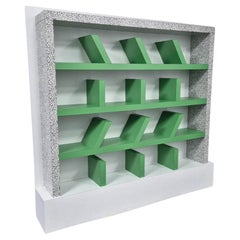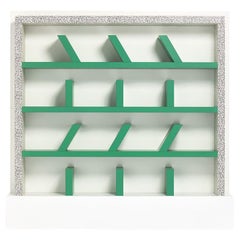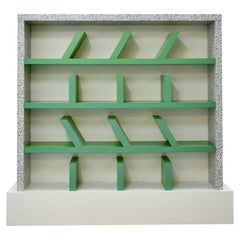Ettore Sottsass Suvretta
Vintage 1980s Italian Modern Bookcases
Laminate, Wood, Plywood, Scrap Wood
21st Century and Contemporary Italian Modern Bookcases
Plastic
Recent Sales
Late 20th Century Italian Post-Modern Bookcases
Wood
People Also Browsed
Vintage 1980s Canadian Post-Modern Stools
Metal
Vintage 1980s Canadian Post-Modern Stools
Metal
2010s South African Modern Chairs
Steel
Antique Early 1800s English Georgian Beds and Bed Frames
Upholstery, Mahogany
Vintage 1950s Swiss Mid-Century Modern Patio and Garden Furniture
Concrete
21st Century and Contemporary Vietnamese Minimalist Side Tables
Wood
21st Century and Contemporary Italian Modern Floor Lamps
Metal
21st Century and Contemporary Chinese Industrial Side Tables
Lava
Mid-20th Century French Art Deco Patio and Garden Furniture
Stone, Wrought Iron
Vintage 1970s Italian Mid-Century Modern Lounge Chairs
Leather, Fiberglass
20th Century American Baroque Fireplace Tools and Chimney Pots
Iron
Vintage 1950s American Mid-Century Modern Contemporary Art
Metal
Mid-20th Century Swedish Bohemian Russian and Scandinavian Rugs
Wool
21st Century and Contemporary Indian Art Deco Cabinets
Bronze
Vintage 1960s French Mid-Century Modern Lounge Chairs
Metal
Antique Early 1900s Victorian Fireplaces and Mantels
Iron
Ettore Sottsass for sale on 1stDibs
An architect, industrial designer, philosopher and provocateur, Ettore Sottsass led a revolution in the aesthetics and technology of modern design in the late 20th century. He was a wild man of the Radical Design movement that swept Italy in the late 1960s and ’70s, rejecting rationalism and modernism in favor of ever-more outrageous imaginings in lighting and furniture such as mirrors, lamps, chairs and tables.
Sottsass was the oldest member of the Memphis Group — a design collective, formed in Milan in 1980, whose irreverent, spirited members included Alessandro Mendini, Michele de Lucchi, Michael Graves and Shiro Kuramata. All had grown disillusioned by the staid, black-and-brown “corporatized” modernism that had become endemic in the 1970s. Memphis (the name stemmed from the title of a Bob Dylan song) countered with bold, brash, colorful, yet quirkily minimal designs for furniture, glassware, ceramics and metalwork.
The Memphis Group mocked high-status by building furniture with inexpensive materials such as plastic laminates, decorated to resemble exotic finishes such as animal skins. Their work was both functional and — as intended — shocking.
Even as it preceded the Memphis Group's formal launch, Sottsass's iconic Ultrafragola mirror — in its conspicuously curved plastic shell and radical pops of pink neon — embodies many of the collective's postmodern ideals.
Sottsass created innovative furnishings for the likes of Artemide, Knoll, Zanotta and Poltronova, where he reigned as artistic director for nearly two decades beginning in 1958. His most-recognized designs appeared in the first Memphis collection, issued in 1981 — notably the multihued, angular Carlton room divider and Casablanca bookcase. As pieces on 1stDibs demonstrate, however, Sottsass is at his most inspired and expressive in smaller, secondary furnishings such as lamps and chandeliers, and in table pieces and glassware that have playful and sculptural qualities.
Sottsass left the Memphis Group in 1985 in order to concentrate on the growth of Sottsass Associati, a design and architecture consultancy he cofounded in 1980.
It was as an artist that Sottsass was celebrated in his life, in exhibitions at the Los Angeles County Museum of Art, in 2006, and the Philadelphia Museum of Art a year later. Even then Sottsass’s work prompted critical debate. And for a man whose greatest pleasure was in astonishing, delighting and ruffling feathers, perhaps there was no greater accolade. That the work remains so revolutionary and bold — that it breaks with convention so sharply it will never be considered mainstream — is a testament to his genius.
Find Ettore Sottsass lighting, decorative objects and furniture for sale on 1stDibs.
Finding the Right Bookcases for You
Whether you proudly shelve your books in regal mahogany or behind glass cabinet doors, an antique bookcase — or perhaps more than one — is essential to creating a cozy nook for any book lover.
As long as curious people have collected stories, we have needed a place to stow them away and preserve them. When auction houses and book dealers proliferated by the late 17th century, the bibliophile was born. And, of course, as with any treasured decorative objects or collectibles, a book lover’s volumes were suddenly worthy of a luxurious display — enter the bookcase.
Americans of means during the 19th century took to amassing art as well as rare books, and bookcases of the era — rife with hand-carved decorative accents and architectural motifs — were ideal for displaying their handsome leather-bound wares.
Although our favorite titles may change over the years, the functionality and beauty of their home within our home is timeless. Even those who don’t covet the perfect home library can benefit from an attractive display case, as bookcases can easily double as charming étagères.
Contemporary and customizable options make it easier for you to find the perfect bookcase for your style and stacks. If you don’t wish to fill your storage piece so that your collection is snug within its confines, incorporate extra space to allow for additional displays and decorative objects. And by introducing a striking dark wood Art Deco bookcase or low-profile mid-century modern design by Paul McCobb into your living room, your signed first editions won’t be the only items making a statement.
Find barrister bookcases, Globe Wernicke bookcases, bookcases with doors and other vintage and antique bookcases on 1stDibs now.


